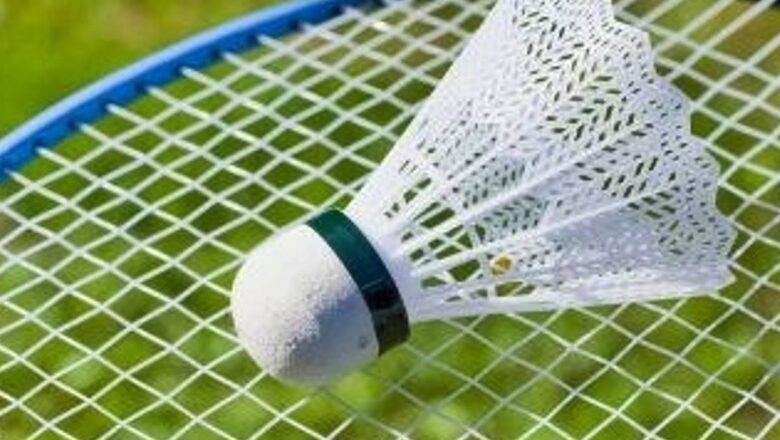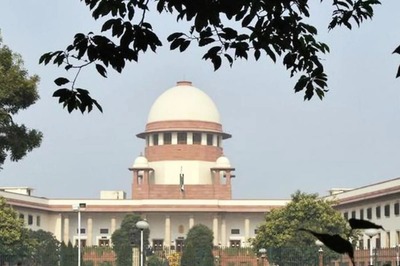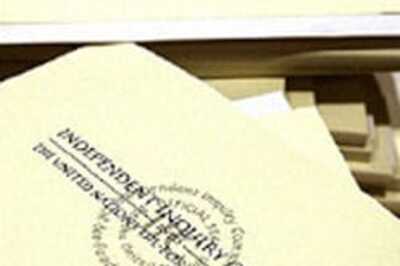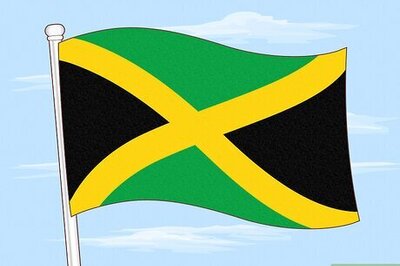
views
Since 2010 we have had great success in the Commonwealth games. Before that, we won a couple of medals, too few and too far between. The badminton renaissance in India started on this fateful year. The medals that came before were purely because of the genius of the shuttlers involved. These medal winners were lone rangers and were really big stars on their own merit. The Badminton Association of India in those years did not do much For the sport. There was no coaching, no academies, and no infrastructure to speak off.
But all this negativity stopped from the day Pullela Gopichand was selected and announced as the chief national coach in 2006 by the then president of the association VK Verma. Gopi had started Coaching in Hyderabad after retiring from the game at age of 34.
The former all-England champion, Gopi was offered to start his own academy at Hyderabad, by the chief minister of Andhra Pradesh. Gopi took up the offer but insisted that he will make his academy in his own way. The academy had everything under one roof, the 8 courts, the well-stocked gymnasium, a huge training ground, a swimming pool, rooms for trainees to stay in, a food mess, you name it and he had it.
When I was writing his authorized biography ‘The world beneath his feat’, he told me,’ I had struggled to get a well-structured training centre in Hyderabad or any place else in the country. The playing court was in one place, the running ground far away, the weights gym in another place, for physiotherapy I had to cycle for many kilometres, and so on. I had seen abroad how the academies functioned, and in even the club in Germany where I used to play in the Bundesliga, everything, every facility required for a shuttler was under one roof.
Starting off in late 2006, this genius had produced Saina Nehwal, a world number 2, and she was followed by a plethora of world-class players one after the other. This was unthinkable in our system, totally unprecedented. Every badminton-playing country was stunned at the way India was moving on the right path to becoming a powerhouse in the game, thanks to Gopi.
Gopi laid out his conditions before taking up the job as chief coach. The target was the 2010 CWG in New Delhi and Verma was keen that India put up a good show. Gopi wanted good exposure for the players in tournaments abroad. He wanted a physiotherapist to travel with the team all the time, and yes he wanted the training centre for the CWG to be based at his academy in Hyderabad. The BAI agreed to all his conditions and that is how the tryst with super success started for Indian badminton.
So in fact, if any person has to be thanked profusely for helping India reach huge heights in the game it has to be VK Verma, who in front of stiff opposition, had the foresight to select Gopi for the post of chief coach. Gopi was not a trained NIS coach and the coterie that ruled India did not want India to bring on the former all-England champion as the chief coach. National coaches in many disciplines had become a monopoly of the NIS diploma holders. Says VK Verma, “things had been static in badminton, with no improvement. Mediocrity had become routine. That is when I was looking to change this coaching system. I had Gopi marked in with a few other coaches to meet me."
Verma says that Gopi was young and seemed to be sincere. Continues Mr Verma" he had that fire in his belly and had a concrete plan to raise the standards of Indian badminton. He wanted to do something for the country and that is what attracted me most. That is when I decided that Gopi will be the chief coach at least till the 2010 CWG. What he has achieved is phenomenal, whichever way one looks at his enormous achievements."
Gopi was lucky in a way that the CWG was the first multi-country and international Olympic committee recognised and administered event he had to face with his squad.
The CWG does not have the depth of Asian games or the Olympics, the world championships, European or the Asian championships or indeed any top-class BWF super 500, 750 or the 1000 events of the tour. The CWG are really weak as they are played only by erstwhile countries ruled by the British. At first for many years it used to be only England that ruled the roost winning almost all the medals except men’s singles which they won only once. That was in 1986 when Steven Baddely snapped up the gold medal.
Then Malaysia came of age and their domination remained for many years. Amongst the serious badminton playing countries, Malaysia was there right on the top for some time. Singapore which was part of the Malaysian peninsula separated in 1965 to become a sovereign state. And many of the top Malaysian players then opted to migrate to Singapore, and they created ripples in the badminton world.
It was up to 1974 that England dominated the CWG. Team championships started from and in this mixed team format, England won till team events till 1994. Being strong in mixed doubles, ladies doubles and ladies singles, the team format was tailor-made for the English.
It was in 1998 that team event was separate for men and ladies, and Malaysia won the first men’s team event, while England won the ladies. In 2002, the old system was brought back and again England prevailed over all opposition. The team gold in 2006 went to Malaysia again, and so did the 2010 CWG in the 2010 and 2014 championships.
However, in the 2018 CWG in Australia, India finally laid the claim to team gold over Malaysia, the defending champions in team CWG.
It is interesting to note that though the games started in 1930, badminton was introduced as a medal sport only in 1966.
Let us now see how India performed at the games since the inaugural badminton debut in 1966.
Dinesh Khanna
It was Dinesh Khanna who set the ball rolling in the CWG when in 1966 at Jamaica he got a bronze for India. Dinesh had won the Asian championships, the first edition was held in Lucknow in 1965. And he was also the national champion of 1965. Let us hear from Dinesh, as to how the team was selected and how it reached Jamaica.
“You know a three-member team was selected for this tournament. Nandu Natekar, Suresh Goel and myself. There used to be huge budgetary constraints during those years. We got just 10 dollars each for everyday expenses. This being an IOC event, the Indian Olympic Association was the main body in the entire process from selection to dispatching the team on its journey to Jamaica.
Of course, there used to be no training camps, in those days. So we were in Delhi waiting to embark on the Jamaican journey when we suddenly got the news that only two players will go plus one official. The BAI wanted to send one official. The secretary of BAI Mr Chaddha was very keen on going to the games.
The IOA took up the case and they ensured that all three went to play. With Nandu officiating as official also. Nandu was wearing three hats in Jamaica, of coach, manager and player. This was also the first time we were given a tracksuit. I had never worn a tracksuit before."
Dinesh said that it was a really long flight to the venue. The flight took 30 hours with stops. The route was Delhi to London to New York and then to Jamaica. The three members team landed well in time and the team had enough practice and rest.
Continues the former Asian champion," Dinesh had easy wins in first two rounds and then met the English national champion Roger Mills in quarter-finals and ensured that Roger was free to savour the delights of Jamaica and get that sun tan on the lovely beaches of the country by defeating him 15-4/15-11 In the semifinals, he ran into the current All England champion Tan Sik Song of Malaysia and lost 6-15/12-15.
But it was a typical style play of Dinesh who was a real rally master. He kept the opponent on the court for a long time and The legendry Malaysian acknowledged this in a statement he gave to the press when he was 57 years old, and I quote," many a time the score line does not justify how strong and tiring a match was. In the 1966 games, I played Dinesh Khanna of India. The match was not easy though I ended up winning in two straight games."
In the bronze playoff, Dinesh met Robert McCoig of Scotland and showed him the exit, 15-7/15-8. And Dinesh still remembers that tingling feeling, the goosebumps when he walked to the podium and saw the tricolour going up. “I felt so proud to see the tiranga being unfurled at the prize distribution ceremony."
Indeed so Dinesh ji as you were surely the first Indian to witness the Indian flag being unfurled. Hats off to you.
Ami Ghia and Kanwal Thakur Singh
To Ami and Kanwal goes the distinction of being the first Indian Female players who won a medal abroad. The two ace players combined well to get a bronze medal at the 1978 CWG games In Edmonton, Canada.
The 23 times national champion, Ami was a phenomenon in her days. She ruled Indian badminton with an iron fist breaking no challenge to her supremacy at the national championships. She got 7 titles in singles, 12 in doubles and 4 in mixed doubles. A highly graceful shuttler she moved around the court as if on rollerskates, the movement was fluent, economical and precise. Nary a wrong step. There was deception on most strokes. A long match with her meant, lots of bandaids next day ornamenting, especially the knees and elbows as you scampered around the court grazing the two mentioned above. She had a pretty good smash which belied a frail frame. Ranked world number 7 at one stage her tragedy was that in those days one got to play just one or two tournaments abroad, and there was hardly any exposure.
I would have loved to see Ami matching sabres with Tai Tsu Ying, the epitome of deception today.
Kanwal Thakur Singh on the other hand was powerfully built and had a well-defined aggressive approach to the game. so it was a great combination, with Ami creating openings and Kanwal providing the scorchers from the baseline.
This duo reached the semifinals without many hiccups but lost to the second seeds from England Nora Perry and Anne Statt who went on to win the gold.
For the bronze playoff, our girls defeated Barbara Sutton and Jane Webster, the top seeds from England, thus becoming the first female players to win an international medal.
“We had prepared well. I remember we had a ten days training camp at Bangalore where we practised lots with the boys squad. There was Prakash Padukone, Syed Modi, Partho Ganguly and Udhay Pawar, and the coach was Mr Puri. Playing with the Boys made us sharp and fit. The journey was long but we got good rest before the matches started. And participating in two tournaments abroad gave us confidence."
Prakash Padukone
The 1978 games not only had Ami and Kanwal getting a bronze, but also, the star player Prakash Padukone who outclassed the field in men’s singles to grab the gold medal. He defeated Derek Talbot of England 15-9/15-8.
This was indeed a stepping stone for better things to come and gave enough indication of the legend he was going to be.
Syed Modi
Late Syed Modi emulated his senior, Prakash Padukone, to win the gold medal in the 1982 edition of the games at Brisbane when he prevailed over England player Nick Yate 7-15/15-7/15-5.
Pullela Gopichand
Gopi won the silver in team championships and a bronze medal in individual men’s singles in 1998
Aparna Popat
This 9 times national champion in continuous years, also qualified for two Olympics and she got 4 medals in CWG. In 1998 she reached the finals but lost out and settled for a silver. Aparna also collected a bronze in ladies team championships. In 2002 she got a bronze in singles and in 2006, she got a bronze in the mixed team championships. A remarkable career.
Aparna is in fact a veteran and most experienced player in the CWG for india as she played in 3 CWG and won medals in all of them. In her own words let us see what she says as she glances back on her career in the CWG.
“I had got a silver in the 1996 World Junior championship and in a way my career in seniors started off with the 1998 games. We had really got good preparation in the national camp in Bangalore and we had good coaches in Prakash Sir (Prakash Padukone) and Uday Pawar. I played well to reach the finals against Kenny Morgan of Wales. But in my semifinals against Julia Mann of England I was down 1-9 and got ten continuous points to claim the match. If you remember in those years women singles used to be of eleven points. So that is a special memory that I cherish."
And the great thing of the 1998 games was that all team players got medals. For Aparna this was her first sports event and she enjoyed herself.
In our squad this time we have PV Sindhu leading a side of very young players like Akurshi Kashyup, Gayatri Gopichand and Tressa Jolly. What advice will she give to our raw youngsters." Just play your best and don’t be nervous. In Sindhu, you will have a great leader and motivator. So take her advice if you want." Concludes this great champion.
Chetan Anand
This four times national champion got three medals in the CWG. Chetan had reached a high world rank of 10. In 2006, he got two bronze medals. A bronze in men’s singles and one in the 2006 team championships.
Abhinn Shyam Gupta
This fantastic player who excelled in the tight defensive game was part of the 1998 squad which won a Silver in team championships. The charge of Gopi’s brigade started from the 2010 games held in New Delhi. India overwhelmed the rest of the field in the 2010, 2014 and 2018 editions of the games. So let’s see what happened with Gopi as the chief national coach, at the helm.
Saina Nehwal
This legendary shuttler won 5 medals at the CWG. Gold in singles at New Delhi in 2010. Defeated Wong Mee Choo of Malaysia in a Titanic battle 19-21/23-21/21-13 as the nation held its collective breath. Facing match point at 18-20 she somehow found that extra energy to fight back winning 5 points in a row to clinch the gold. She was to say later," when I was match point down it was a real shock. It was a big match and winning it meant a lot to me. Even years from now people will remember how I fought back and won. It is a proud feeling."
In the 2018 games, Saina defeated PV Sindhu to grab the gold. This living icon got the third gold when India stunned Malaysia to win the gold in the team championships. The last two medals came in team championships. Silver in the 2010 games and bronze in 2006.
Jwala Gutta/Ashwini Ponappa
Jwala/Ashwini broke the jinx as far as doubles were concerned when 32 years after Ami/Kanwal had got the Bronze in 1978, they played outstanding doubles to get a gold in ladies’ doubles in 2010. The duo also got a silver in the team event in 2010. Another silver came in doubles in the 2014 games at Glasgow. The last medal was team Bronze in the 2006 games at Melbourne.
PV Sindhu
This fantastic shuttler has three medals from the commonwealth games. Gold in team championships in 2018. She had also lost the singles finals to Saina and had to be contented with the silver. She also picked up a bronze in the 2014 games in Glasgow.
Parupalli Kashyap
And last but not the least is Parupalli Kashyap who created history of sorts by getting gold medal in the 2014 games. The gold coming 32 years after agonizing wait. His name is written alongside such legends as Prakash Padukone (1978), Syed Modi (1982) and is esconced in a group of three.
He defeated Derek Wong of Singapore 21-14/11-21/21-19 in the finals. But he had to play his heart out to subdue Rajiv Ouseph of England in the semifinals, thus avenging his defeat at the hands of Ouseph in the semifinals at the 2010 games in Delhi. Kashyap had to accept bronze at the Delhi games. Some Consolation was that in team games in 2010 he got the silver medal.
Read all the Latest News and Breaking News here



















Comments
0 comment